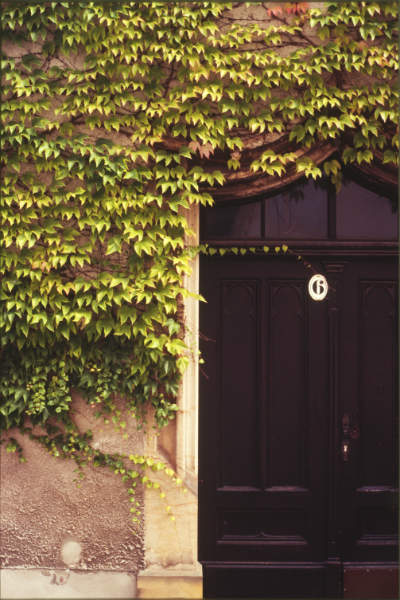Maximilian Götz
www.goetz.pro
The Fujica ST801 Camera
Published 11 June 2024, filed under "cameras"
The Fujica ST801 is a relatively little known 35mm SLR from the 1970s. Its features and design make it pretty much the ideal classic 35mm camera as it would be pictured by most. Considering its lack of fame, causing moderate prices, the ST801 might offer a great price-performance ratio.
Overview
The ST801 was manufactured from 1972 all the way to 1978, from what I can gather. There were two versions: one with a big chrome Fujica logo on the front and a later one with a thinner, wider engraved logo. Some copies are silver, others black.

Sample photo, taken in Freiberg, 2023
The camera operates fully mechanically. No batteries are needed, other than for the light meter. The focal plane shutter has a top speed of 1/2000s, which made it really quite fast for its time. The electronic flash sync is limited to 1/60s, which was common for the time. The slowest shutter speed is 1s, plus bulb, of course. One nifty feature here is that the shutter release button can be locked. There are no auto exposure modes on this camera, it is all manual.
The viewfinder is really, really bright. I cannot stress enough how much of a benefit this really is. Composing with this viewfinder is very easy and quick, even under bad lighting conditions. It has a thread for screwing in additional accessories.
Sadly, there is no mirror lock up functionality. A hot (!) shoe is available but there are individual FP and M flash connectors on the front, too. The winding mechanism is smooth, albeit not as smooth as the Nikon F3’s.
Metering
The Fujica’s light meter was innovative as it used seven LEDs the photographer had to “center” instead of a more traditional needle which moved around. This is a good thing because that renders it unsusceptible to mechanical failure and is, in my opinion, quicker to read. It is averaging, works through the lens (TTL) and uses silicon cells. The battery needed is of the type PX28, no mercury! This is a good thing these days as mercury batteries are not available anymore. Its ISO range goes all the way from 25 to 3200, which is just fine for real world usage.

Sample photo, taken in Saxony, 2023
With coupled lenses, it can measure with the aperture wide open. More on that below.
Build Quality
The camera’s body is made entirely out of metal. It is quite heavy and feels substantial in the hand. Nothing rattles, creaks or makes other unwanted noises or feels loose. It is a well-built, compact package, weighing in at roughly 625g.
Lenses and Accessories
Its M42 mount enables the Fujica to take a massive amount of lenses. As screw mounts were eventually replaced by various bayonet mounts, manufacturers stopped screw mount lens production. That means that the camera’s lens pool, albeit huge, is limited mostly to ancient, early SLR era lenses. Newer coatings and improved optical formulas are out of the question. Whether that is a problem is up to the reader to decide. I personally prefer newer lenses for improved sharpness.
Many better M42 lenses have also become quite expensive, although good deals are still to be had occasionally.
One thing to keep in mind is that the Fujinon M42 lenses feature a coupling tab for light metering. Lenses which do not feature said tab have to be metered stopped down! Coupled lenses can be somewhat hard to find at times. As far as I can tell, the camera was bundled with the EBC Fujinon 55mm f1.8 normal lens. It performs and is built well but it was the only coupled M42 lens I ever had.
Included with the camera came a black leather carrying case. The one that came with mine had essentially disintegrated. Considering the camera itself was in great shape without any marks, the case probably saw a lot of use and abuse throughout its long life.
The camera does not allow for a motor drive to be attached as far as I remember.
Reliability
Being fully mechanical, there is less that can go wrong than on an electronic camera. And if something does, the camera will be far easier to repair. The light meter not only relying on silicon cells but also using LEDs for readout should be really reliable and long-lived, too.
I have yet to hear stories of this camera breaking or losing accuracy. Even the shutter speeds were within spec on my copy.
Pricing and Conclusion
When I sold mine in almost mint condition, I scored 80€ for it, including its deteriorated leather case and the 55mm f1.8 lens. Considering what it is, that was a great deal for the buyer. I got my hands on it for free, even.
If you can find this camera at such a low price in good shape and do not need automatic features, this camera is an amazing deal, especially if you get some coupled lenses with it. Of course, it does not have some more professional features like mirror lock up or a high flash sync speed but for most use cases, it really is ideal. It is pleasant to use and the really bright viewfinder certainly contributes to that. Owners get a reliable, compact, well-built, mechanical, manual camera here.
I only ended up selling mine because I had no real use for it, considering I have a Nikon F3 with some good glass in all the focal lengths I need. I never managed to find the Fujinon lenses I was looking for, at reasonable prices at least. Third party lenses were mostly out of the question for me because stop down metering would have been required. The lack of an aperture priority mode also made this camera somewhat inconvenient for me since I use that a lot on other cameras. It just saves a lot of time.
Got any questions or comments? Let me know via mail!